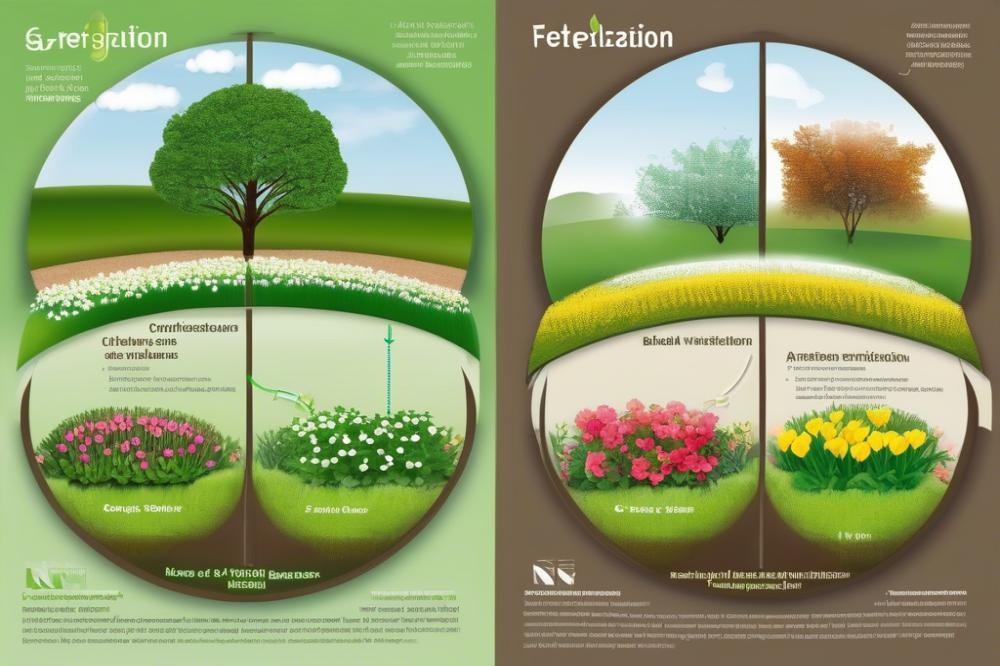Introduction
Understanding the right time to fertilize your garden is essential for maintaining its health throughout the year. seasonal fertilization plays a crucial role in plant nutrition, enhancing growth and overall vitality. Different seasons create varied conditions that affect how nutrients are absorbed by plants. Being aware of the specific fertilizer types suitable for each season helps in maximizing their effectiveness.
Spring is a time of awakening in the garden. During this season, new growth begins, and plants crave extra nutrients. fertilizing properly in spring prepares your garden for the energy it will need during the warmer months. Summer feeding becomes vital as plants continue to thrive. It is an opportunity to support their growth during the peak of their life cycle.
As autumn rolls in, it is the perfect moment to prioritize autumn care. This period demands a shift in focus, where the goal is to prepare plants for winter. Adequate nutrients during fall help strengthen roots and enhance overall resilience. On the other hand, winter protection practices can safeguard your garden from harsh elements. Applying organic fertilizers at this time can provide essential nutrients that slowly release, benefiting plants in the spring.
Soil health is a major concern in gardening. Understanding nutrient timing allows for better application techniques, ensuring that plants receive food when they need it most. Regular and appropriate fertilization contributes significantly to efficient garden maintenance. Overall, grasping these concepts leads to a flourishing and vibrant garden, suited for every season.
Understanding fertilizer types


Choosing the right fertilizer is an important task for gardeners. There are two main categories: organic fertilizers and synthetic ones. Each type affects plants and soil differently. Organic options come from natural sources, such as compost, manure, or bone meal. They improve soil health over time by adding organic matter. Microorganisms break down these materials, enriching the soil with nutrients. Plants benefit from this slow release of nutrients, which aligns well with natural growth patterns.
Synthetic fertilizers, on the other hand, are chemically manufactured. They offer concentrated nutrients that plants need. A common concern with synthetic options is their potential to harm soil health. Continuous use can lead to nutrient imbalances and may reduce organic matter. However, when applied correctly, synthetic fertilizers can support rapid growth. Timing becomes crucial; for instance, spring fertilizing can give plants a much-needed boost as they wake from dormancy.
Understanding nutrient composition is key when selecting fertilizer types. Each kind has different ratios of nitrogen, phosphorus, and potassium. For many plants, spring fertilizing focuses on nitrogen, promoting leafy growth. In summer, feeding might shift to a balanced formula that supports both growth and blooming. Autumn care may require fertilizers higher in potassium to help plants prepare for winter. During this season, plants need to store energy to survive the cold months.
Winter protection is equally essential, even if the plants aren’t actively growing. Some gardeners choose to apply organic fertilizers in late fall. This gives the soil time to absorb nutrients and remain healthy. Other techniques may include mulching to keep the ground insulated. Timing nutrient applications properly throughout the seasons allows plants to thrive.
Garden maintenance involves considering the specific needs of each plant. Understanding these needs helps in picking the correct fertilizing method. Different plants have varying nutrient requirements at different growth stages. Regular soil testing also offers insight into nutrient levels and deficiencies. Maintaining proper nutrient timing and using the right application techniques can enhance overall plant health. Each step taken makes a difference in the long run.
Spring Fertilizing


Spring is a crucial time for fertilizing your garden. As plants emerge from their winter dormancy, they require a boost. This moment, when life starts to reawaken, emphasizes the importance of nutrient timing. Without the right nutrients, plants may struggle to grow strong and healthy. Understanding the best practices for fertilization can make a noticeable difference.
Choosing the right fertilizer types is essential. Organic fertilizers are often preferred for their ability to improve soil health. They release nutrients slowly, providing a steady supply that aligns with plant growth. Chemical fertilizers can also be effective but should be used carefully. A balanced fertilizer, high in nitrogen, phosphorus, and potassium, can support overall growth. Pay attention to the specific needs of your plants when making your choice.
Proper application techniques can enhance the benefit of your fertilization efforts. Broadcasting fertilizer evenly across the soil allows for uniform distribution of nutrients. Alternatively, you might consider side-dressing plants as they grow. This method places nutrients close to the root zone. Watering after application aids in nutrient absorption, helping plants take up what they need. During spring, increase your garden maintenance routine. Monitor soil moisture and plant health regularly.
With summer approaching, plants will demand more food during their active growth. This highlights the need for frequent assessment of nutrient levels. As you fertilize in spring, think ahead to summer feeding. Regular observations will help you adjust your fertilization plan as necessary. Different plants might require varied treatments, so individual attention is key.
Finally, remember that building a healthy foundation benefits the garden year-round. As you finish spring fertilizing, consider how your plants will fare in autumn care and winter protection. Planning for seasonal changes helps in maintaining a thriving garden. Every season presents new challenges, and being proactive can lead to spectacular results.
Summer Feeding


As summer arrives, plants enter their peak growing season. This period is crucial for their development and productivity. During summer feeding, the application of fertilizers becomes essential to support this vigorous growth. Plants require balanced nutrients, including nitrogen, phosphorus, and potassium. These elements promote healthy foliage, strong roots, and vibrant blooms.
Stress factors such as heat and drought can affect plant health. When temperatures rise, plants may struggle to absorb enough water and nutrients. It’s important to respond with the right fertilizers to help them thrive under these conditions. Timing of nutrient delivery is key. Applying fertilizers in the early morning or late afternoon can minimize evaporation and maximize effectiveness.
Organic fertilizers are an excellent choice for summer applications. They not only provide nutrients but also improve soil health over time. Compost, manure, and other organic options enhance microbial life in the soil. This vibrant ecosystem helps plants access nutrients more efficiently. When selecting a fertilizer, look for ones with a balanced ratio. This balance will cater to the needs of various plants in your garden.
Different fertilizer types exist for specific requirements. Granular options offer slow-release capabilities, while liquids allow for quick nutrient absorption. Thoughts about application techniques should vary based on your garden’s needs. A thorough watering after application can help distribute nutrients effectively. Avoid over-fertilization, as this can lead to nutrient runoff and harm local waterways.
Regular garden maintenance plays an integral role in summer feeding strategies. Monitoring plants for signs of nutrient deficiency is vital. Yellowing leaves or stunted growth may indicate a need for additional feeding. Also, routine checks on soil moisture levels will help manage hydration during hot months.
In the grand cycle of seasons, summer feeding stands out. It represents a time to nurture and invigorate the plants that bring life to our gardens. While spring fertilizing sets the foundation, summer is when everything comes together. Care during this period can lead to lush greenery and bountiful harvests.
When autumn arrives, consider how to transition care for the plants you’ve nourished all summer. Begin to think about winter protection to prepare them for the colder months ahead. Meticulous planning will help ensure a healthy garden year-round.
Autumn Care


Autumn presents a crucial window for fertilizing your garden. As temperatures cool, plants prepare for dormancy. The right nutrients during this time can enhance root development and overall resilience. Focus on providing the correct fertilizer types to support these processes.
Nitrogen, phosphorus, and potassium are the primary nutrients plants need. During autumn, fertilizers with a lower nitrogen content are preferable. An increase in phosphorus can promote strong root systems. This shift helps plants withstand harsh winter conditions. Organic fertilizers can also be beneficial, as they improve soil health over time.
Timing is key when it comes to nutrient application. Fertilizers should ideally be applied before the first frost. This allows plants to absorb essential nutrients before they enter a dormant state. Consider testing your soil to understand what nutrients are lacking. A soil test guides your choices in adding amendments.
Application techniques matter as well. Spread granular fertilizers evenly across the soil and avoid direct contact with plant stems. When using liquid options, dilute them according to package instructions. Water them in well afterward to help nutrients reach the root zone.
While you focus on autumn care, be mindful of the environment. Minimize runoff by avoiding over-application. It’s important not only for plant health but also for local ecosystems. Keeping your garden well-maintained throughout the fall will aid in winter protection for plants.
Moreover, integrating summer feeding practices before this time can further prepare your garden for autumn fertilization. A holistic approach to garden maintenance throughout the year strengthens plants against seasonal changes.
Winter Protection
Protecting soil health and nutrients during the cold months is crucial for any gardener. When winter arrives, many plants go dormant, but the soil continues to need care. Cold temperatures can lead to nutrient loss, making it essential to implement effective strategies.
One way to preserve soil quality is by using cover crops. These plants grow during the winter and prevent soil erosion. They also help retain moisture and add nutrients back into the soil when they decompose. Legumes, for instance, can fix nitrogen, enriching the soil for next season.
Mulching is another important practice. It provides a protective layer over the soil, shielding it from harsh winter conditions. Organic mulches, such as straw or shredded leaves, not only help maintain soil temperature but also slowly break down, contributing organic matter. This process benefits soil health and structure.
Certain fertilizer types can be applied before winter, serving as a safeguard. For example, applying organic fertilizers rich in nutrients can prepare the soil for spring fertilizing. It is important to select the right products and follow proper application techniques to maximize benefits while preventing runoff.
During winter, it’s vital to monitor soil moisture levels. Saturated or frozen soil can lead to compaction and nutrient leaching. Ensuring that the soil remains somewhat dry but not completely dry will help maintain its quality.
Additionally, consider using techniques like winter gardening to keep the soil alive. This includes using cold frames or hoop houses to extend the growing season. By doing this, soil organisms remain active, which is essential for nutrient cycling.
In summary, winter protection is about combining various strategies to maintain soil health. Implementing cover crops, mulching, and careful fertilizer application can significantly improve garden maintenance during the harsh months. Taking proactive steps now will yield better results during the growing seasons of spring and summer.
Application Techniques
Fertilizing your garden effectively depends on the right application techniques. Different methods can help maximize nutrient uptake for your plants. It’s crucial to match the technique with the season and the specific fertilizer types you’re using.
Broadcasting
One common technique is broadcasting. This involves spreading granulated fertilizers evenly across the soil surface. It works well in spring fertilizing when plants are waking up. Apply it before rain or watering to help the nutrients soak into the soil. Choose a calm day to avoid wind blowing particles away. This method is quick but might not reach deep soil layers.
Top-Dressing
Top-dressing is another method to consider. It involves applying a layer of organic fertilizers directly on the soil or plants. Summer feeding with this technique can refresh nutrients and improve soil health. Grass lawns often benefit from top-dressing; it promotes strong growth without disturbing roots. Make sure to scrape aside any mulch first for better contact with the ground.
Liquid Applications
Liquid applications offer a different approach. These can be used for both quick fixes and regular garden maintenance. They deliver nutrients directly to plant leaves and roots. Timing is key in using this method, especially during autumn care. Nutrients can be absorbed faster through leaves, making it good for stressed plants. Dilute the liquid correctly to prevent burning the foliage.
Importance of Timing
Each technique’s effectiveness greatly relies on timing. Spring fertilizing focuses on encouraging growth, while summer feeding helps sustain vigor. Autumn care supports plants as they prepare for dormancy. Winter protection often involves adjusting soil nutrients to keep plants healthy throughout the cold months. Regular monitoring of soil health also supports better fertilization practices.
Using the right application techniques allows gardeners to optimize their efforts. Experimenting with different methods can reveal what works best for your specific plants. Pay attention to the needs of your garden and adjust your strategies accordingly. In the end, enriching your soil contributes to the overall health of your plants.
Looking Ahead: seasonal fertilization Insights
The journey through the gardening year is a dynamic one. Each season brings its own challenges and opportunities for growth. Understanding the specific needs of plants during these times is crucial for thriving gardens. Key takeaways highlight that adapting your fertilization strategies to align with seasonal cycles can yield better results.
In spring, fertilizing is essential to kickstart growth. Plants awaken from dormancy and need nutrients to flourish. Using slow-release fertilizers during this time can provide a steady supply of the necessary components. It’s also a good opportunity to assess soil health and make adjustments where needed.
Summer presents another unique scenario. Plants often bloom vibrantly and may require additional nourishment. Watering becomes critical, as it is easy for nutrients to wash away. Monitoring moisture levels can help you decide when to reapply nutrients without overdoing it.
As fall approaches, it’s time to prepare for winter. Fertilizing during this season focuses on building strong roots. Applying the right fertilizer types can fortify plants for the cold ahead. Enriching the soil with organic matter also supports beneficial microorganisms that improve soil health through the winter months.
Winter, while dormant for many, should not be overlooked. Testing soil can provide insights into the nutrients that may be needed when spring returns. Being proactive during this time can streamline your efforts when the days get longer and warmer.
Being mindful of these seasonal cycles not only fosters healthy plant growth but also ensures vibrant garden ecosystems. Each season requires a commitment and understanding of what is best for the plants and soil. By implementing these best practices, gardeners can cultivate stronger, more resilient landscapes year-round.



